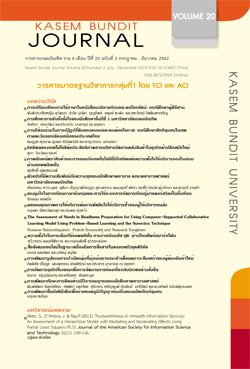Akter, S., D’Ambra, J. & Ray,P.(2011). Trustworthiness in mHealth Information Services: An Assessment of a Hierarchical Model with Mediating and Moderating Effects Using Partial Least Squares (PLS). Journal of the American Society for Information Science and Technology, 62,(1): 100-116.
Keywords:
Partial Least Square Path Modeling, moderator, mediatorAbstract
Based on a research report, this research article exemplifies the use of partial least square path modeling for an evaluation of a model of mobile telemedicine services. The model consisted of trustworthiness as a second order latent variable and as the independent variable directly, and indirectly through consumer trust, the mediating variable, influencing continuance in service use, which was the dependent variable. Moreover, the analysis also demonstrated that trustworthiness was not the moderator between consumer trust and continuance in service use.
References
Jeon, Jihye. (2015). The Strengths and limitations of Statistical Modeling of Complex Social Phenomenon: Focusing on SEM, Path Analysis, or Multiple Regression Models, International Journal of Social, Behavioral, Educational, Economic, Business and Industrial Engineering. Vol. 9(5): 1634-1642.
Khanthachai, N. (2562). Article Review: Bagozzi, Richard P. (2010). Structural Equation Models Are Modeling Tools with Many Ambiguities: Comments Acknowledging the Need for Caution and Humility in Their Use. Journal of Consumer Psychology 20(210): 208-214. Kasam Bundit Journal, Vol.20 (special edition) April-May, 2562: 150-153.
MacCallum, Robert C. & Austin, James T. (2000). Applications of Structural Equation Modeling in Psychological Research. Annu. Rev. Psychol. 51: 201-226.
Ronkko, Mikko, McIntosh, Cameron N., Antonakis, John & Edwards, Jeffrey R.(2016) Partial Least Squares Path Modeling : Time for Some Serious Second Thoughts. Journal of Operations Management DOI:10.1016/j.jom.2016.05.002
Rose S. A., Markman, B. & Swilowsky, S. (2017). Limitations in the systematic analysis of structural equation model fit indices. Journal of Modern Applied Statistical Method, 16(1): 69-85.
Tomarken, Andrew J. & Waller, Niels G. (2005). Structural Equestrian Modeling: Strengthes, limitations, and Misconceptions. Annu. Rev. Clin. Psychol. 1: 31-36
Xiaosong Peng, David & Lai, Fujun. (2012). Using Partial Least Squares in Operatrions Management Research: A Practical Guideline and Summary of Past Research. Journal of Operations Management, 30: 467-480.
Downloads
Published
How to Cite
Issue
Section
License
ทัศนคติ ความคิดเห็นใด ๆ ที่ปรากฏในวารสารเกษมบัณฑิตฉบับนี้เป็นของผู้เขียน โดยเฉพาะ มหาวิทยาลัยเกษมบัณฑิตและบรรณาธิการ ไม่จำเป็นต้องมีความเห็นพ้องด้วย







